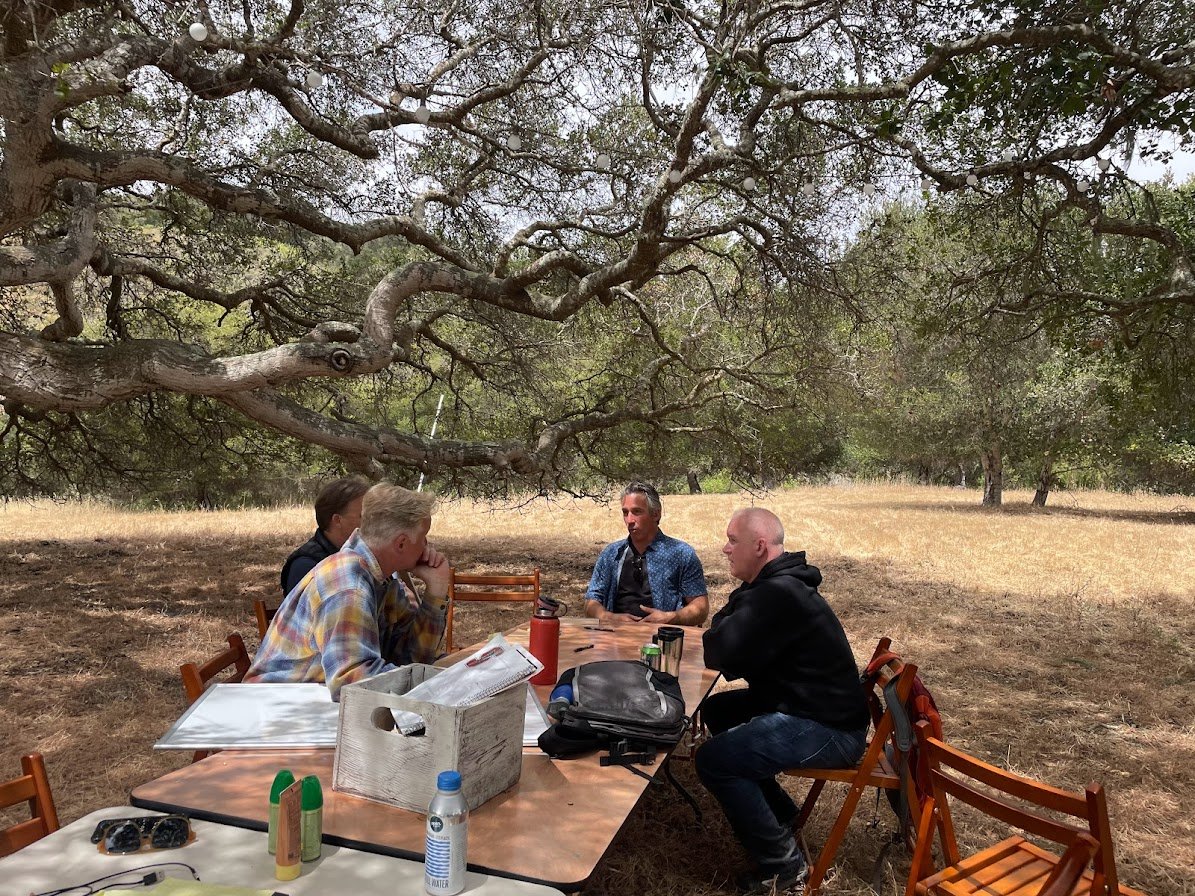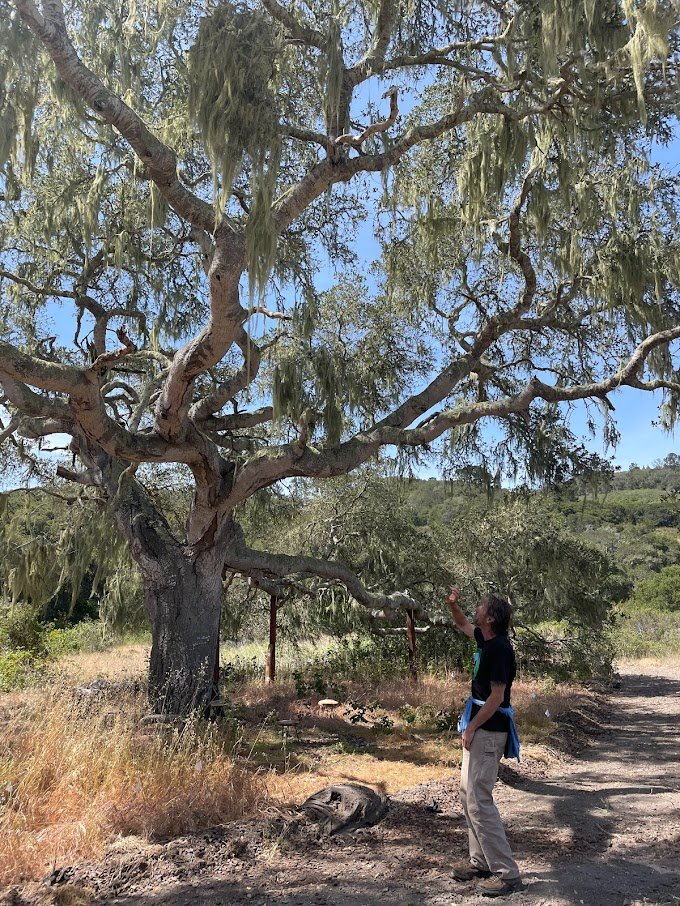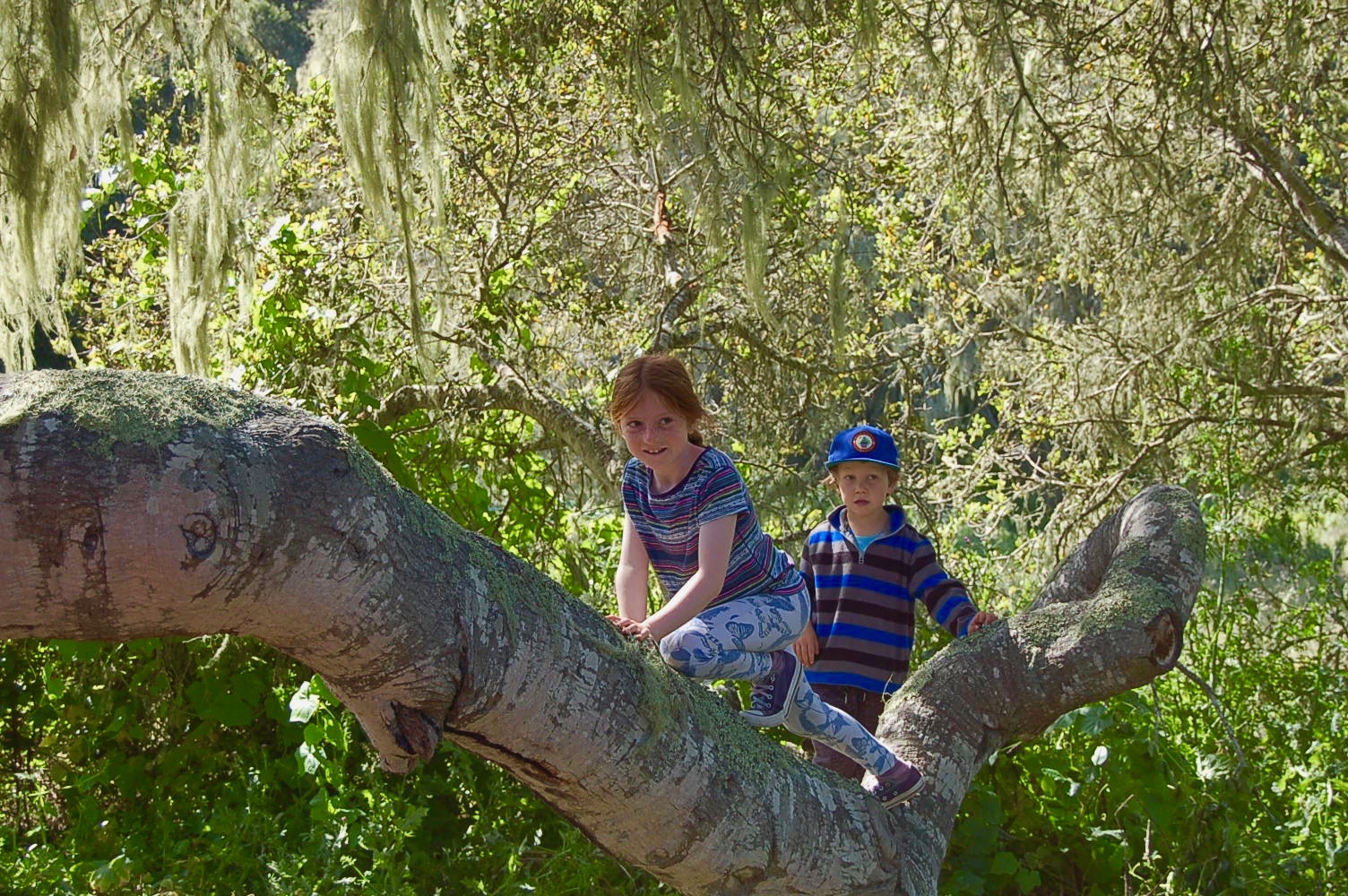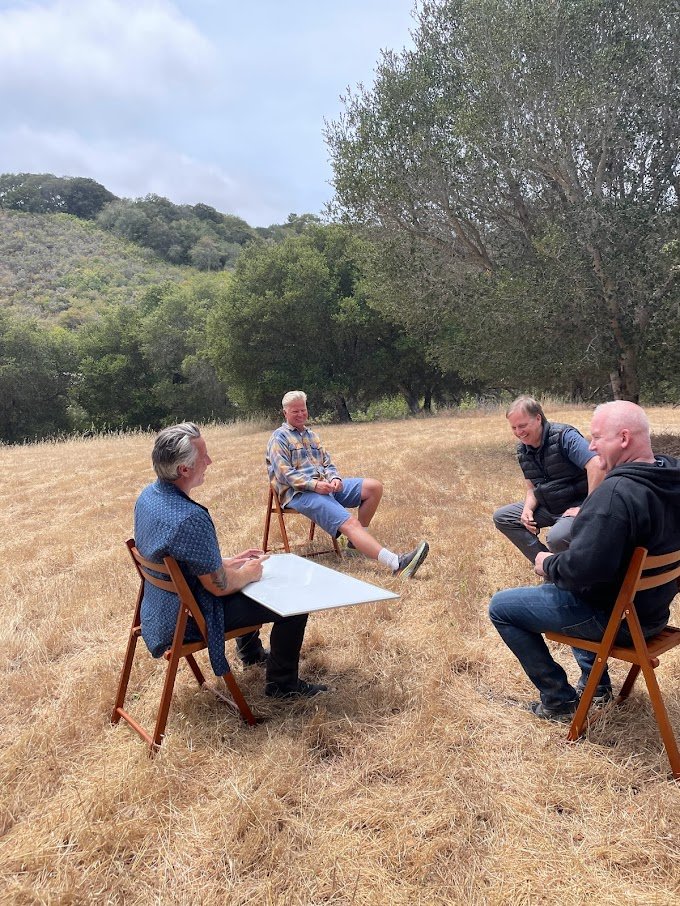Regenerative Practices Through Nature's Blueprints Gathering Summary
June 3rd, 2022
The Need
During the Apollo 17 mission, the crew snapped the first photograph of the whole world from space 50 years ago. An iconic image, this image is one of the most reproduced in history. During the 1970s there was a surge in environmental activism, and the drawing became a symbol for the movement -- illustrating nature's fragility, vulnerability, and isolation.
“The Blue Marble”
Our moral responsibilities have accrued over the past fifty years. It will be five decades since the first UN Conference on Human Environment in 1972 when the UN General Assembly convenes Stockholm +50 meeting. As part of the same year, the Club of Rome issued its report Limits to Growth, warning that economic growth without heed to environmental concerns could result in a global economic and ecological emergency. The sudden escalation of new geopolitical emergencies has led to an era of multiple and cascading shocks, from a pandemic to the global financial crisis and growing inequality, as poverty remains a harsh reality for millions around the world.
Yet “Limits to Growth” wasn’t an attack on unbridled economic expansion. In fact, the report argued that if the “unlimited-growth” pathway was chosen, it would require complementary policies (including funding) to preserve the planet’s finite life-support systems. That’s where and how we must urgently and collectively step up.
A series of opportunities awaits leaders in the coming month to accomplish just that. During Stockholm +50, the UN will promote the implementation of the 2030 Agenda and the Sustainable Development Goals. Even though it receives less attention than other major policy forums, it is still an important moment for building momentum on "transformational change" -and exploring the policies and measures that will help us accomplish it.
As a result of the Paris Agreement, we began a shift towards a low-carbon economy and were given the tools we need to continue to decarbonize. The IPCC's recent climate report found that greenhouse gas emissions should be halved every decade starting in 2020 with increased investment in renewable energy and massive biodiversity protection. The IPCC strongly recommends significantly increasing regenerative food production. The existing food system needs to be drastically overhauled if almost ten billion people are to be fed by 2050. The West needs new development models to cover future needs, following the examples of Costa Rica, Colombia, and Gabon, which are placing nature as a core part of their economies.
The next meeting of the Convention on Biological Diversity will also take place in June, which will be an important milestone toward finalizing the world's action plan for stopping and reversing biodiversity loss by 2030. The sticking points seem to be many, but all inherently center around human well-being, the introduction of more sustainable production pathways, how we live, and the development of equity and justice.
In order to save the planet and ourselves, these high-level fora provide opportunities to address a critical question: do we reward short-term gain while destroying the environment and while impoverishing and disabling communities for the long haul?
Nature Conservancy and the Paulson Institute analyzed costs of biodiversity preservation globally in September 2020 in partnership with Cornell Atkinson Center for Sustainability. Researchers found that, while the global economy spent between USD 124 billion and USD 143 billion on activities that benefit nature in 2019, far more was spent on activities that adversely affect Earth's biodiversity and abundance. Between USD 598 billion and USD 824 billion more will be required to protect and restore nature than is already being spent.
More recently, a new study co-funded by The B Team and Business for Nature shows the world is spending at least USD 1.8 trillion every year—equivalent to 2% of GDP—on subsidies that are destroying nature. Climate adaption, nature restoration, and livelihood reconstruction should be invested in instead of all this.
Our experience with the past 50 years shows we need to move beyond business as usual to counteract the climate crisis and the destruction of the natural world. Our ambitions must now be translated into action, and we must capitalize on growing awareness and concern. An international survey conducted last year among 20,000 people of the G20 countries, the global world's largest economies, found that three out of five (58%) are either "very" or "extremely" concerned for the future of the commons. The majority of people (73%) are concerned about abrupt or irreversible changes on earth by the result of human activities.
In 1950, we were able to launch people nearly 30 thousand kilometers into space and take a photo of the Earth; this was an incredible achievement. As stakeholders from around the world gather for this year's important policy conferences, it is time to channel that level of ambition. We are more than two years into the UN Decade of Action, and there is no time to waste. As many of us spend more time at work than ever before, we have become accustomed to the idea that we see our bosses and colleagues more than we do our families, while spending more time in front of a screen rather than nature.
Why Gather?
How will we re-define work?
These challenges aren't insurmountable.
THE WALDEN GATHERING Searched to answer questions:
What does it mean to be regenerative?
How can a business become regenerative?
How can we as individuals utilize regenerative approaches?
What can Nature and history teach us about operating in a more holistic manner?
Working Together
A Sustainable World, Created Through Collaboration
Creating a world that values purpose, productivity and preference isn't something that can happen overnight. It will require not only hard work and perseverance, but also a deeply rooted collaboration with organizations who value the possibility of a better tomorrow over the profits of today.
“If your marriage counselor asked you how everything is going and you responded ‘It’s sustainable’ - how do you think your partner would feel?”
Gathering Discussions
setting the tone through INTRODUCTIONS
We started the day with a rigorous networking hike around the Walden property. A steady uphill climb among the leafy coastal oaks, let us breathe and introduce ourselves in a relaxed style as a group of individuals from diverse backgrounds and fields joined the discussions.
“Within the next five years What do you Expect for yourself?”










“I cannot remember the books I’ve read any more than the meals I have eaten; even so, they have made me.”
“We use a design-thinking format around the table, walking discussions on nature trails, and guided meditation to inspire the group to solve big problems. Instead of the hyper-intense networking of your typical conference, participants spend the entire day outside with a carefully curated small and diverse group of people.”
After the Gathering intro, members presented current issues, focused on:
History
Nature
Self
Desire
During these discussions, participants break up into groups to increase contributions and engagement. Topics are addressed, opinions are shared and summaries are presented to all.
Common Threads in Shared Stories
Change society by living an alternative story and astonish every day
Don’t ask what the world needs, instead do what makes you feel alive, that’s what the world needs
Bring people together to do cool things
We live in a Star Wars world of Good and Evil
My grandmother was 104 Irish woman living off the land. That doesn’t happen nowadays..
The only way forward is to go backwards
Lead by example and create ripple effects
How do I find someone that knows more than me on a topic
Pay attention.
Be astonished.
Tell about it.
Recent Bali trip in hotel where every plant had a purpose. Soaps, waste treatment, food, and medicines.
Key Themes
Nature As A Catalyst
Key Takeaways from Discussions
Developing countries have been living off the land for thousands of years.
Aspirin is Birch Bark resold by western medicine., Plants instead of Prozac (SSRIs)
Natural world is part of their society, we have become too removed from it.
Indigenous cultures found ways to work with plant medicines
We need to focus on a regenatory economy.
Spiritual practices around the world use plants from the natural world. Western and eastern (natural) health can co-exist.
Seed —> Sprout —> Root
Fire can improve the environment.
Pineal gland is a seed in humans to reconnect us with the seed of Mother Earth. Everything came from a seed.
Stewardship is essential to species survival.
Not just economic, think spiritual/emotional
Nature is: calming, healing, fun
Change the what and how thinking.
Using Nature As Inspiration
For all the innovation and technological advances modern humanity has made and continues to make, we have one bad habit we seem unable to break. It always seems that as soon as one major problem is dealt with. It is always a matter of the next disaster, the problem at hand, the pressing concern, and then as soon as it no longer seems to be a matter of life and death that must be immediately dealt with, it's no longer dealt with at all, it is relegated to the back of the line as new crises take its place, sometimes the new crises arising directly from the solutions that were implemented to solve previous crises.
Long before humankind was designing and constructing anything, quite frankly long before humankind existed, nature was designing all sorts of complex structures. And the end result exists all around us, endless blueprints that contain fascinating and elegant solutions to problems that we have never considered.
Nature does not see a problem and then set out to find a solution. Rather, nature reacts to the present reality not with solutions but adaptations. It takes what is already there and builds what will fit. The designer that is nature doesn’t look for problems to solve, but opportunities to grow and to innovate.
When we look at one of the most famous examples of nature inspired design, it’s easy to view the innovation as being born to solve a problem. The shape of the front of the Shinkansen bullet train used the inspiration of the design of the kingfisher bird’s beak in order to solve the solution of the loud tunnel boom that was created when the train moved transitioned from different air pressures at extremely high speeds when it exited a tunnel. And while the engineer, Eiji Nakatsu, did use his love of bird watching to solve that problem, that same solution also led to the Shinkansen train traveling 10% faster while using 15% less energy. Those are pretty great side effects to have when implementing the solution to a problem: it will fix the problem, but also it will save money, be more efficient and better for the environment. That is quite the win-win, but it’s not a coincidence that the solution that comes from nature provides results that are even better than what was originally needed.
When nature, the designer, designed the kingfisher’s beak, it didn’t say, “well the problem is that the kingfisher needs to go from air to water without making a splash,” and then make a beak that provided a solution to the splashing problem. Rather there were once some birds, the ancestors of the kingfishers that had a beak that was especially well-shaped for going from air to water. And those birds successfully caught and ate fish and had offspring and passed on the effective shapes of their beaks to the young that were successful to survive and have offspring of their own. And as the beaks changed over time, it wasn’t the beaks that were best shaped to minimize splashing that were naturally selected, rather it was the beaks that were most effective overall, the ones that allowed the bird to move most efficiently, using the least amount of energy and allowing the bird to most effectively catch its prey. And that’s what we get every time we use nature the designer as our inspiration. Designs that have been created not to solve problems but to find and create opportunities to flourish.
“What I see in Nature is a grand design we can understand only imperfectly, one with which a responsible person must look at with humility.”
Regenerative Practices
Key Takeaways from Discussions
Regeneration Process applies to life.
Incentives to change
Transform - Socially/Spiritually
Don’t just engage in NOW thinking.
Turn waste intro resources & problems into solutions
Lead by example and create ripple effects.
Circularity
Cradle to grave
Leave it better than you received it.
Create good for net positive.
Weave together individual to collective.
You don’t have a snail problem, you have a duck deficiency,
Economy is based on growth and it's not sustainable. Need to change the focus. Focus on sustainability not growth. (Can the economy handle this?)
This peninsula is a great example of sustainable focus not growth focus.
Resource grab (Ukrainian war) is an example and lopsided growth in the US is another.
Is Sustainability Enough?
EXTRACTIVE - DOING HARM
SUSTAINABLE - MINIMIZING HARM
REGENERATIVE - LEAVING IT BETTER
Regenerative Business Practices
Regenerative Business Practices are ones that leave capital intact or better off functionally speaking and which do not draw down resources.
Whereas a sustainable firm seeks merely to reduce its ecological footprint, a regenerative company boldly seeks to increase its socio-ecological handprint—as Harvard professor Greg Norris puts it—by restoring the health of individuals, communities and the planet. In doing so, regenerative businesses can achieve greater financial performance and impact than their sustainability-focused peers.
Although many enterprises and manufacturers have taken major steps to make their supply chains more sustainable in an effort to fight climate change, are we there yet?
GM recently appointed its first chief sustainability officer Dane Parker to drive the carmaker and the nation towards an all-electric, zero-emissions future (GM plans to produce 20 new all-electric vehicles by 2023).
By adopting the circular economy principles aimed at zero-waste, SC Johnson has already made 94% of its plastic packaging recyclable, reusable, or compostable.
Levi Strauss is shaking up the apparel sector, a top contributor to global warming, by committing to reduce its greenhouse gas emissions within its own facilities by 90% by 2025.
These are notable steps which should be applauded, but regenerative doesn’t stop at sustainable efforts and should spread across the entirety of an enterprise, community or individual. Taking into consideration:
BUSINESS | ECOSYSTEM | STAKEHOLDERS | DESIGN | TECHNOLOGY | DATA
Regenerative Agriculture
Regenerative agriculture means enhancing the resiliency of farms, boosting sustainability and biodiversity in the process. It takes a holistic approach to farming that considers the entire ecosystem, compared to industrial farming which is more about scheduling inputs and outputs to attain short-term goals.
MINIMIZE SOIL DISTURBANCE | MAXIMIZE CROP DIVERSITY | KEEP THE SOIL COVERED
FOLLOW CROP ROTATION | INTEGRATE LIVESTOCK
Permaculture
Permaculture is a philosophy for a sustainable, holistic lifestyle. The term was coined in 1978 by the ecological researcher and writer, Bill Mollison. Permaculture is a system of ecological farming that combines the words permanent and agriculture. In time, they changed it to permanent and culture in order to cover people's social and housing needs.
Permaculture attempts to work with nature while not conflicting with it. Wild ecosystems regenerate and maintain themselves on their own. These processes are observed by permaculture practitioners, who recreate them on their farms or in their backyards.0
In spite of being mainly an underground social movement, permaculture's ideals and concepts have been trending toward mainstream acceptance. Even though its peddlers may sound like they belong on Portlandia with all their talk about mandalas and herbs spirals, permaculture is the backbone of every idea about sustainability that is thrown out by both the media and restaurants.
Closed Loop Systems - Sustainable systems provide their own energy needs. This concept can be extended beyond things like biofuels and solar power to what permaculturists call “inputs,” like food and fertilizer. By eliminating the need to import fertilizer to a farm or garden, the system can instead establish its own fertility sources, such as livestock manure or cover crops.
You don’t have a snail problem, you have a duck deficiency,” Mollison was fond of saying, which makes perfect sense if you’ve ever seen how gleefully ducks wolf down snails.
Multiple Functions AKA Stacking - A permaculture idea is that every aspect of a structure or landscape is meant to serve more than one function. Through the strategic design and placement of components, it is possible to create a self-sufficient, integrated system. It is possible to design a fence that functions as a windbreak, a trellis, and a reflective surface to provide excess heat and light to nearby plants, in addition to serving as a windbreak and trellis. Rain barrels can also provide irrigation water for fish and aquatic plants.
Let Nature Do the Work for You - The permaculture creed is perhaps best captured in the Mollisonian mantras of “working with, rather than against, nature” and of engaging in “protracted and thoughtful observation, rather than protracted and thoughtless labor.”
Fire Mimicry
Sudden Oak Life is a movement aimed at improving the health of trees and forests in California and elsewhere through practice, education, and research.
Our numbers include tree care professionals, forest scientists, master gardeners, school teachers, organic farmers, homeowners, college students, and plain ol’ tree huggers, who follow a ecological model of tree health, one that considers the ecology of forests and soils in the prescription of methods and compounds designed to improve the site quality and soil fertility. Our approach is analogous with the wellness model of human health in that it pays particular attention to nutrition and alkalinity of the ecosystem.
We contend that the great oak forests of California are largely the product of traditional land care practices by Native Americans over thousands of years. Native people understood that oaks, pines, and many other trees are “fire-adapted” (meaning that the overall health of the forest is improved by periodic fire), and they used this knowledge in applying fire wisely to the land, thus keeping plants and soils healthy.
Now, with the displacement of the native people, the lands are no longer being managed with fire. Strict fire suppression measures have resulted in forests that are overgrown and the soils depleted in nutrients. With the loss of vitality, trees are succumbing to catastrophic wildfires, diseases, and pests at ever-increasing rates.
The solutions put forth by Sudden Oak Life do not focus on treating a particular disease or insect. Rather they are designed to help the trees through environmental practices that mimic fire. As practitioners of ecological tree care we employ a suite of methods that involve clearing, pruning, soil remineralization, composting, mulching, and more. All materials are natural products commonly used in organic agriculture. We do NOT advocate the use of any toxins, including chemical fertilizers, fungicides, or pesticides.
Regenerative Self Care
Become Nature-Connected
Inter-Educate Yourself
Regenerate Your Inner Landscape
The Science Behind A Walk in the Woods
It turns out there are some amazing scientific reasons why a walk in the forest feels so good. Trees contain essential oils that get released into the forest air. When we walk under and among trees, we breathe in these near-magical oils, and that does a world of good for our health. Right away, our energy levels increase by more than 30 percent. We sleep better and longer too; a two-hour walk among trees increases the amount of sleep by an average of 15 percent.
It's not just a coincidence that being in the forest puts you into such a good mood -- feeling less stressed, less anxious, less depressed, and less angry; studies show that being near trees significantly reduces the amount of stress hormones in our bodies. As if that's not enough, inhaling these tree oils is good for the heart, the circulation, and the immune system.
The Japanese Practice of Forest Bathing
The Japanese have taken this idea of gaining health benefits from being near trees and turned it into an art form. Instead of these benefits being a side effect of spending time in nature, they have become the reason to go to the forest in the first place. The Japanese call these health-seeking experiences in nature shinrin-yoku, which means "forest bathing."
Shinrin-yoku is an ancient practice in Japan, but it has become wildly popular with the recent publication of the bestselling book Forest Bathing: How Trees Can Help You Find Health and Happiness by Dr. Qing Li, a leading expert in the science of forest medicine.
“Real, sustainable community change requires the initiative and engagement of community members.”
WALDEN GATHERINGS ARE NOT JUST FOCUSED ON TALKING ABOUT SOLUTIONS, BUT PUTTING SOLUTIONS INTO ACTION.
While ideas are shared throughout the day, we gather to create change.
In order to improve the world around us, we must not only speak about the issues at hand, but work towards solutions. The point of the discussions is to establish the framework for identifying and understanding the problems.
What follows, is most important.
Discussions
Fire breaks/ clearing is a big responsibility but necessary to avoid catastrophic fires.
Be aware we are part of, NOT other than,
MeEarth is producing produce for the community.
Turn a liability into a responsibility.
Educate kids.
Put Lee on stage to teach and inspire.
Nature introduced to youth (river walks, Yosemite trips) turned into a larger community in nature.
Horse manure was taking over San Fran and it looked like the city would be buried, then Henry Ford came along and the rest is history. We need to remember that this will happen again.
Use ancestral knowledge.
Use tech to help spread the message.
Train low income teens in this skill (Forest Restoration Management)
We need to stop fighting fires in the worst of conditions and focus on fighting them when conditions are right.
Lead by example for the ripple effect.
Turning Ideas Into Solutions
Support & Advocacy for SuddenOakLife
Emerging Ideas
Re-Utilize Ancestral Knowledge
Seed | Sprout | Root
Re-Educate
If our ancestors were able to share this knowledge in the past, we certainly can now!
Stewardship
Stewardship is essential to species survival. Not just economic, but spiritual & emotional
Lead by example for the ripple effect.
“Design is a formal response to a strategic question.”
Team
We aim to bring together passionate individuals, groups and organizations to gather, learn and collaborate in small groups on how best to contribute and invest their time, talent and resources to innovative solutions -- and then take them back into the world. We see everyone who joins as an equal expert at the table because we believe in the wisdom of the crowd to find solutions.
Scott Liess | John long | JC Myers
Lee Klinger | Quentin Topping | Brian Bajari
Gloria Correa |Nick Jekogian | Edward Dooling
Check Out/ Further reading:
World Population
Watch human population grow from 1 CE to present and see projected growth in under six minutes. One dot = 1 million people.

























